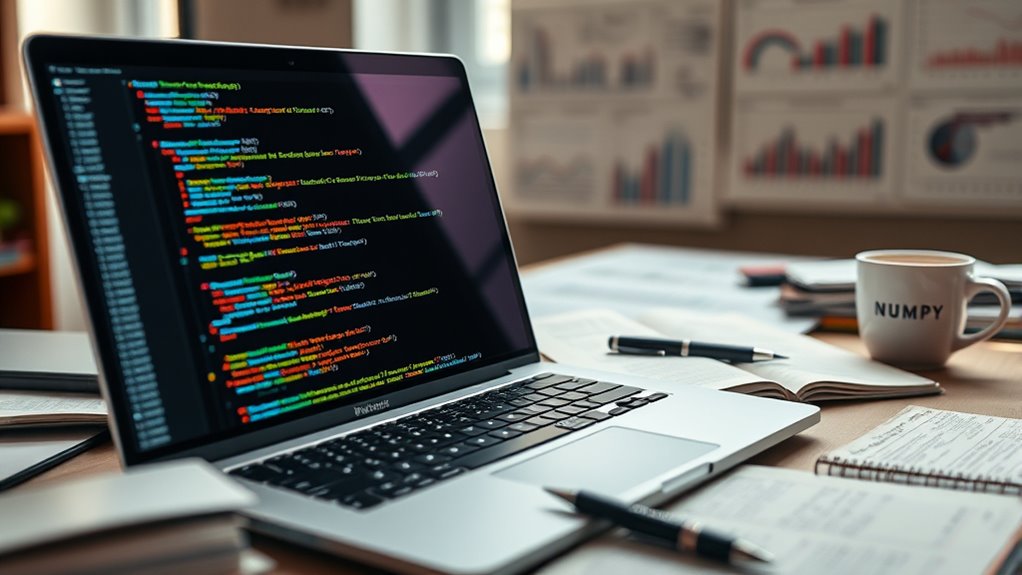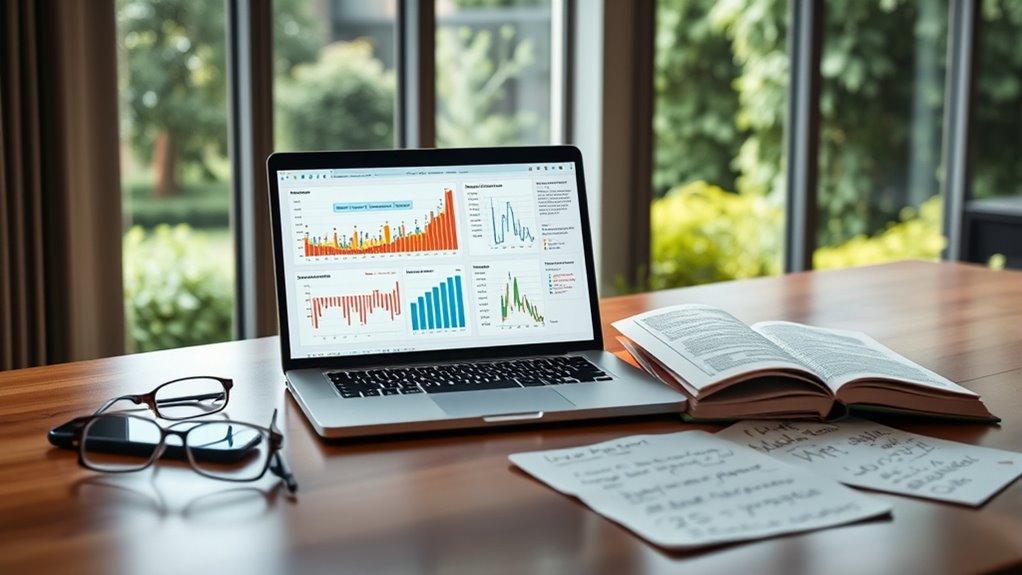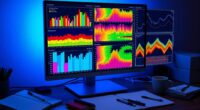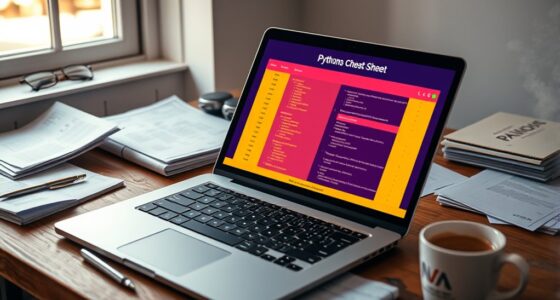Pandas and NumPy are vital Python libraries that help you perform statistical analyses and handle data effectively. Pandas simplifies data cleaning, organization, and visualization with functions like grouping and plotting, making your workflow faster and less error-prone. Meanwhile, NumPy provides efficient array operations for calculations like mean, median, and standard deviation, supporting complex statistical tests. Mastering both will open powerful data insights—stick with it to discover more tools and techniques for your projects.
Key Takeaways
- Pandas provides DataFrames and Series for efficient data organization, cleaning, and manipulation before statistical analysis.
- NumPy offers fast array operations and functions for calculating basic statistics like mean, median, and standard deviation.
- Combining Pandas and NumPy enables comprehensive data analysis workflows, including data cleaning and complex statistical testing.
- Pandas integrates with visualization libraries to graphically explore data distributions, correlations, and outliers.
- NumPy’s numerical capabilities support large-scale data computations and advanced statistical modeling in Python.

Have you ever wondered how developers quickly build complex applications in Python? One of the secrets lies in the powerful libraries they use, especially when it comes to handling data and performing statistical analysis. Two of the most essential libraries are Pandas and NumPy. Together, they streamline tasks like data cleaning and data visualization, making your workflow more efficient and less error-prone.
When working with large datasets, data cleaning is a critical step. Pandas makes this process straightforward. It offers flexible data structures such as DataFrames and Series that allow you to easily manipulate and tidy your data. You can handle missing values, filter out irrelevant information, or transform data types with just a few lines of code. For example, if you have a dataset with inconsistent date formats, Pandas can standardize them effortlessly. This cleaning process guarantees your data is accurate and ready for analysis, saving you from potential misinterpretations caused by messy data. Besides cleaning, Pandas excels at organizing your data for deeper insights, enabling you to sort, group, and aggregate with ease.
Data visualization is another essential aspect where Pandas and NumPy shine. While Pandas integrates seamlessly with visualization libraries like Matplotlib and Seaborn, it also offers built-in plotting capabilities. Visualizing your data helps you identify patterns, trends, or outliers that might not be obvious from raw numbers. For example, after cleaning your data, you can quickly generate histograms or scatter plots to explore distributions and relationships. NumPy complements this by providing efficient numerical operations, allowing you to perform statistical calculations such as mean, median, or standard deviation directly on your datasets. These insights form the foundation for making informed decisions based on your data.
NumPy, in particular, powers many statistical functions behind the scenes. Its optimized array operations enable you to perform calculations on large datasets without sacrificing speed. This efficiency is essential when you’re working with big data or performing complex statistical tests. Combining NumPy’s numerical capabilities with Pandas’ data handling makes your analysis more robust and accurate. You can easily compute correlations, regressions, or other statistical measures, integrating these results into your data visualization to present a complete view of your findings.
Frequently Asked Questions
How Do I Handle Missing Data With Pandas?
To handle missing data with pandas, you can use methods like `dropna()` to remove missing values or `fillna()` for data imputation. If you want to replace missing data, choose an appropriate value or statistic, such as the mean or median, and apply `fillna()`. This approach helps you manage missing data effectively, ensuring your analysis remains accurate and reliable without losing valuable information.
Can Numpy Perform Advanced Statistical Tests?
Yes, NumPy can perform advanced statistical tests, including hypothesis testing and multivariate analysis. You can use functions like `numpy.linalg` for matrix operations or combine NumPy with SciPy for more complex tests, such as t-tests or chi-square tests. While NumPy provides the core numerical tools, integrating it with SciPy enhances its ability to handle sophisticated statistical analyses, helping you explore data relationships and validate hypotheses efficiently.
What Are Best Practices for Large Datasets?
When working with large datasets, you should prioritize data sampling to analyze manageable portions without overloading memory. Use memory optimization techniques like chunking data and selecting efficient data types. This approach helps you process data faster and reduces resource consumption. Always monitor your system’s memory usage and optimize your code accordingly, ensuring smooth analysis without crashes or delays.
How Do I Visualize Data Directly From Pandas?
Think of pandas plotting as your magic wand for data visualization. You can directly visualize data from pandas by calling the `.plot()` method on your DataFrame or Series. It offers various charts like line, bar, histograms, and more. Just make certain you have matplotlib installed, and you’re ready to create insightful visuals effortlessly. With pandas plotting, your data tells a story at a glance, making analysis both quick and engaging.
Are Pandas and Numpy Compatible With Other Libraries?
Yes, pandas and NumPy are highly compatible with other libraries. You can easily perform data merging, normalization, and transformation using them before visualizing with libraries like Matplotlib or Seaborn. They integrate seamlessly, allowing you to prepare data efficiently, combine datasets, normalize values, and then pass the processed data to visualization tools, making your analysis workflow smooth and effective.
Conclusion
By mastering pandas and numpy, you unlock the toolbox to turn raw data into meaningful insights. Think of these libraries as your compass and map, guiding you through the vast wilderness of statistics with confidence and precision. With each line of code, you’re not just crunching numbers—you’re weaving a story from data, transforming chaos into clarity. Embrace these tools, and you’ll find yourself steering the world of data with the surefootedness of a seasoned explorer.










